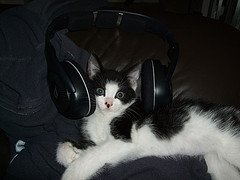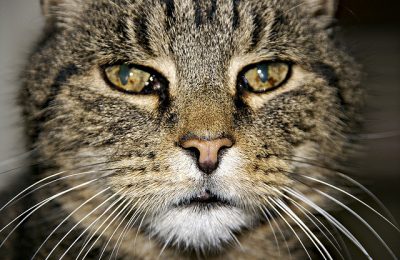
I’ve previously blogged about musical animals, and many believe that musicality (at least to the extent we see in humans) is unique to humans. We love music so much that we seem very determined to try and see if other animals love it too. Music is commonly used as enrichment for captive animals, or music is forced upon other animals (for example, many folks who clean animal cages like to listen to music while doing so, and I know my kitties have to listen to a lot of punk rock, probably against their will!). But do animals LIKE music? A recent study, “Cats Prefer Species-Appropriate Music,” looked at whether cats enjoyed music that was designed to be “species-specific” in its frequency and other characteristics. Let’s take a closer look at what the research revealed!

Previous research on music as an enrichment for lab animals has shown mixed results. In general, loud noises are stressful to most captive animals; background sounds may inhibit an animal’s ability to communicate with other animals. But in some cases, introduced sounds (white noise or music) can act as a buffer from other less predictable background noises (such as construction or traffic). Animals that have been tested on responses to music seem to prefer classical (shucks for me) over other styles and lower volumes seem to produce less stress.
We can’t assume that animals hear music the same way we do, as most species have ranges of hearing that are different than human hearing. So it makes sense that music used as enrichment for animals should be in a range that animals use for communication or other survival skills, which is exactly how the authors of the current study designed the music they tested. They predicted that cats would be more responsive to this “cat music” (Cozmo’s Air and Rusty’s Ballad) than “human music” (which was regular old classical music – Gabriel Fauré’s Elegie and Johann Sebastian Bach’s Air on a G String). The cat music is classical in style with frequencies in cats’ range of hearing and tempos similar to purring or suckling, and the human tunes were chosen because they had tempos similar to the human resting heartbeat.

Forty-seven cats were tested on their responses to the cat and human music, by playing the different styles of music for each cat via a laptop and speakers placed on either side. The researchers noted whether the cats showed positive behaviors (orienting their head to the speaker, movement toward or rubbing against the speakers, and purring) or negative behaviors (leaving, growling, hissing, arching their back) when listening to the music.
The results suggested that the cats showed more orienting and approach behaviors to the cat music than the human music, on average 1.5 behaviors toward the cat music (range of zero to 3.75) and 0.25 behaviors toward the human music (range zero to 3 behaviors). They also approached the cat music faster than the human music (if they approached at all). Negative responses were few and far between, and pretty much the same regardless of the type of music.
From this, can we conclude that cats like music made for cats? Not so fast.

While I’m happy to concede that statistically the cats did show more orienting behaviors (and how do we know that is only a positive response?) toward the cat music, a few things should be noted. First of all, the music that was made for cats was not just music. Cosmo’s Air features squeaky bird/mouse-like sounds, and Rusty’s Ballad essentially sounds like a purr over classical music. The manuscript describes the cat music as incorporating “features to make the music interesting to cats,” but they did not really describe what those features were. To truly determine if the species-specific MUSIC is what the cats responded to, it would have been good to have a control condition where the cats heard purring or chirpy/squeaky sounds without music. Otherwise, we don’t know if it was the music the cats were responding to, or just the “interesting features.” You can listen to snippets for yourself here.
You can listen for yourself because sample sounds are available on the website for the product the study authors are selling, Music For Cats. Which brings me to my second concern: there is no disclosure anywhere in the manuscript that this research is being used to sell a product that the authors could financially benefit from. Not that they are likely to become billionaires on this product, nor is it wrong to test your products in a scientific fashion. But it is considered good form to mention this somewhere in the manuscript, so people can be aware of any biases that may have affected the study in any way. A conflict of interest is when an author has financial interests including “financial relationships, for example equity ownership or investment interest or intellectual property rights (e.g. patents, copyrights and royalties from such rights).” The authors do have a patent out on “species-specific music.”
Now, at the end of the day, I’m always happy to see more behavioral research done on cats. I tested out Cosmo’s Air on my own cats and they were definitely curious (and promptly started wrestling with each other). The study authors bring up a very important point – if music is to be used as enrichment, it should actually be ENRICHING. Enrichment should be tested on every species that might be using it, looking for positive or adverse effects. Enrichment is not just adding things to an animal’s environment, enrichment should have species-specific properties. And that’s something I hope we all can agree on, even if I didn’t like every aspect of this study!




As much as I would enjoy engaging in a dialogue on a number of points made in the article, I have been busy lately and will have to restrict my comments to two important points.
The first point concerns the proposal that “…the music that was made for cats was not just music.” Musical notation was used for every line and all sounds heard in the cat music were produced by the human voice, cello, harp, or violin. If I had given the sheet music to any musician to play, the result would have been the same as mine. It seems to me that the real issue is one of assumptions. In a human music corollary: if I were to have invented the pedal drum and beat it every second, I could easily be accused of simply replicating the sound of the human heart instead of creating “music”.
The more important issue, and the reason I am responding here, is that of self interest. The manuscript does include under the heading Conflict of interest “none declared”. Under the next heading Acknowledgments it states: “DT was responsible for development of the theory and composing the music. CTS and MES designed the study and carried out the research and data analyses independently of DT.” This means that there was a barrier between the composer (myself) and those doing the testing (Chuck Snowdon and Megan Savage). In fact, I remember an occasion when the testing was underway in the earlier study on the monkeys when I called Chuck to ask how things were going. He said to me: “I don’t know and I wouldn’t tell you if I did. Those doing the testing are naive to the result we expect to find and we must not communicate with them until all the data are in.”
I want it to be understood that Dr. Snowdon has earned his highly-respected stature in the scientific community not only through his unwaveringly caring, humane treatment of the subjects of his studies, but also through his rigorous attention to true scientific methodology.
– David Teie
David,
Thanks for writing to clarify a few issues. While I stand by my critiques – mainly that the “features…interesting to cats” (as they were described in the manuscript) should have been tested on their own (I am fascinated to know those features were created using instruments thought!) and that the financial interest should have been declared – I appreciate you taking the time to write and tell us more about your methodology. I am always excited to see non-invasive, behavioral research on pet cats and other animals.
Best,
Mikel
Hi Mike,
I do appreciate your support of the concept of research that hopes to find new and effective ways of enriching the lives of animals in our care.
The question of the separate testing of elements is one that has been brought up by all reviewers of our papers. The reason that the elements must be presented concurrently is because of the nature of recognition and combination sensitivity. That is to say, in order for a stimulus to be recognized as having emotional valence, it must satisfy a number of varied conditions such as frequency range, waveform, timing, etc. Getting each element right independently would not trigger recognition and would not work as human music does, by presenting an array of stylized representations of recognized sounds that are emotionally relevant.
Ahh… I wish I had more time to discuss! Maybe in the next life….
– Dave